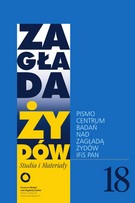„Rowy leśne” i miejsca, których „w ogóle nie ma”. Harcerski Alert Zwycięstwa 1965 jako przyczynek do badania pamięci o Zagładzie
"Forest ditches" and places that "do not exist at all". Scouting Alert of Victory 1965 as a contribution to the study of the memory of the Holocaust
Author(s): Katarzyna GrzybowskaSubject(s): Studies in violence and power, WW II and following years (1940 - 1949), Post-War period (1950 - 1989), Fascism, Nazism and WW II, History of the Holocaust, Politics of History/Memory, Peace and Conflict Studies
Published by: Stowarzyszenie Centrum Badań nad Zagładą Żydów & IFiS PAN
Keywords: Jews; Holocaust; alert for scouts; place of memory; non-place of memory; grave, burial site; the Polish Scouting and Guiding Association (ZHP); places of struggle and martyrdom;
Summary/Abstract: Organized in cooperation with the Council for the Protection of Monuments of Struggle and Martyrdom, the nationwide ‘reconnaissance’ conducted by the Polish Scouting and Guiding Association was held in 1965. It was to commemorate the 20th anniversary of the Polish People’s Republic by recognizing its achievements and commemorating those who had died in the fight against Nazism or had fallen its victims. The purpose of the alert was also to supplement the ROPWiM’s records of the places of national memory with new, previously uninventoried and unknown locations on a wider scale. The three-day intense ‘reconnaissance’ resulted in the drafting of thousands of reports which were sent to the ZHP Headquarters. Among the reports there were also those concerning the Holocaust, namely reports on execution and burial sites. The alert’s special value consists in the fact that the teams had to ind places in their immediate vicinity (up to eight kilometers from their school). Consequently, they interviewed the local witnesses. In the reports created during the campaign, one can find traces of hesitation and linguistic incongruence when the report authors were referring to unmarked mass graves. The hand-drawn maps prepared by the scouts, which were included in the reports, are also highly valuable. This rich source material should be analyzed while bearing in mind the political and propaganda activities accompanying that campaign. Their recognition can be aided by reading the surveys conducted during the reconnaissance. The analysis of this material can constitute a step toward understanding the dynamics of the formation of places and non-places of memory and the local processes of remembering.
Journal: Zagłada Żydów. Studia i Materiały
- Issue Year: 2022
- Issue No: 18
- Page Range: 440-461
- Page Count: 22
- Language: Polish

